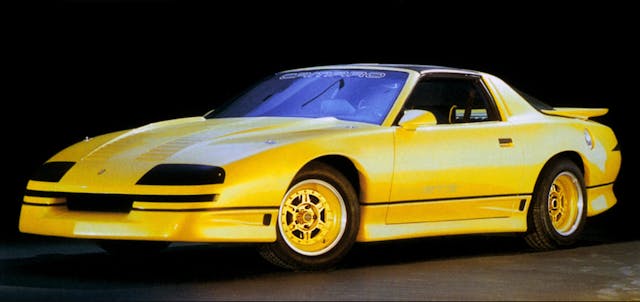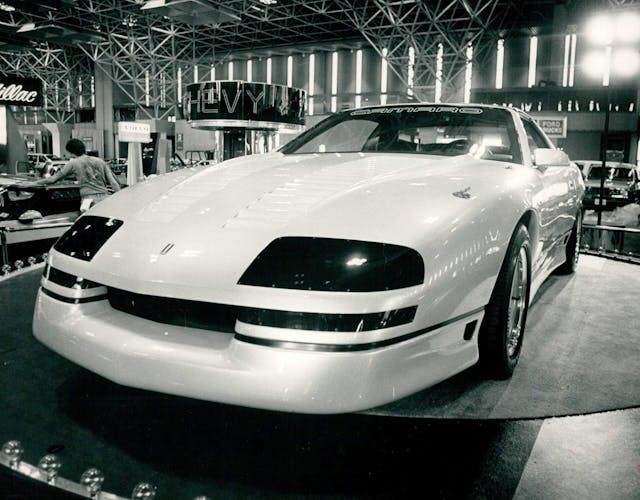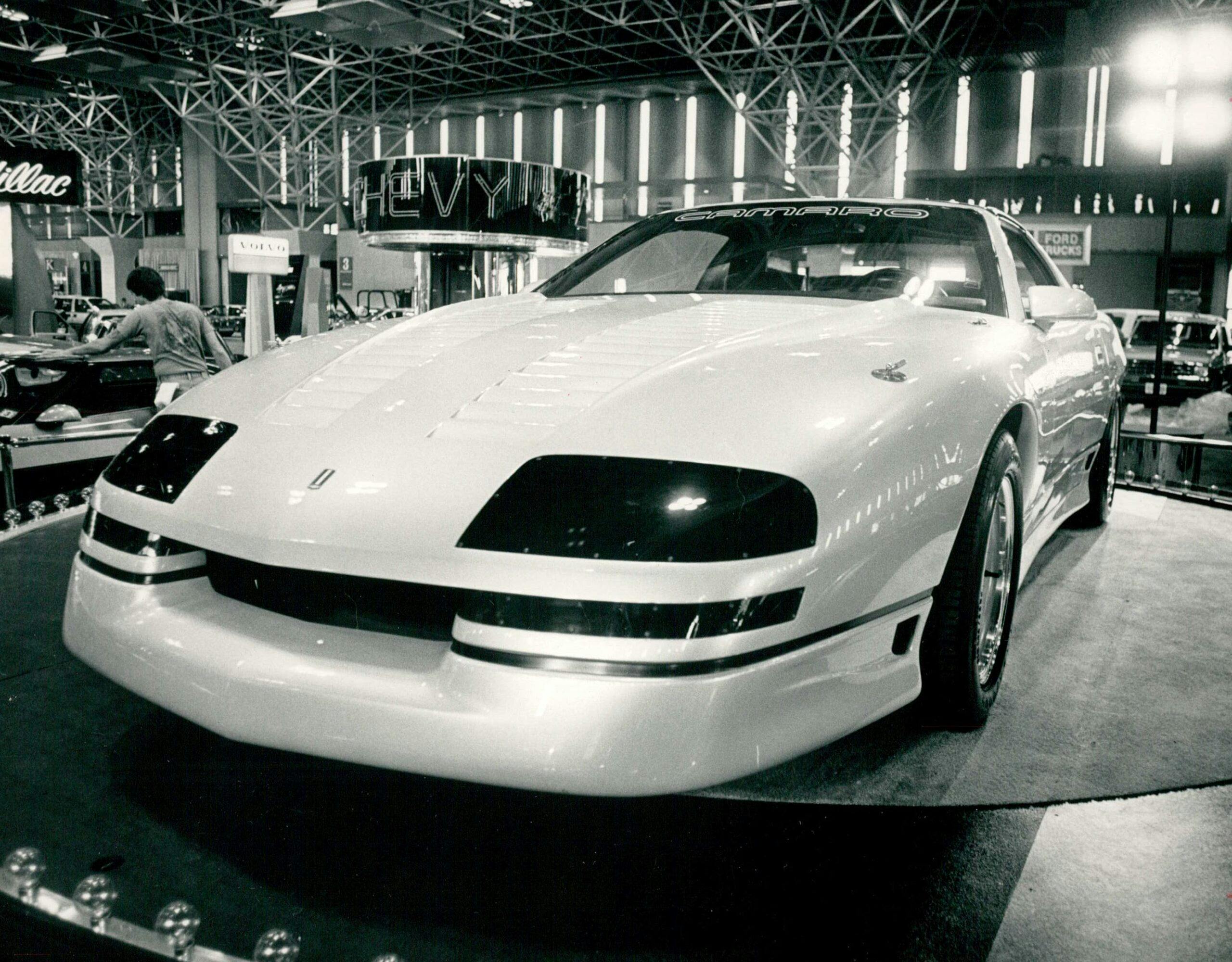Media | Articles
4 unique Camaros that time forgot
With the Camaro nameplate retiring soon, we’re honoring the beloved two-door with a series of love letters, fun lists, and memories that you can follow here. Many performance cars, especially nowadays, aim for an anodyne version of perfection that only a few can afford. The Camaro is for the rest of us—and it’s always ready to party.
If there’s one thing that my obsession with automotive history has taught me, it is to be very careful with declarations of the absolute. In the annals of any long-running nameplate, there seems to always be an odd one out, an exception, an often-forgotten footnote. That’s what makes the subject so rich and interesting, and that of Chevrolet’s pony car is no exception. In the spirit of our recent love letters to the departing Camaro, here are four unique Camaros that time forgot.
1968 Camaro CS Coupe Frua

A key element of the Camaro story is the development blitz that took place after the 1965 Ford Mustang’s success caught GM off balance. Still, none of that haste was apparent in the Camaro’s refined looks. Under the stern watch of the legendary Bill Mitchell, GM Design hardly put a foot wrong with its pony car. But Mitchell was dismissive of the first Camaro’s design due to the many compromises deemed necessary for cost reasons. We’d nevertheless argue that the original Camaro looked great even in basic trim, thanks to its crisp lines, perfectly judged proportions, and deftly modeled surfaces.
Most would conclude there was little room left for aesthetic improvement, but that didn’t stop the Italians from saying “Hold my Nebbiolo.”
Presented by the Turinese coachbuilder Pietro Frua at the 1968 Paris Motor Show, the Camaro CS Coupe was a sleek 2+2 that wouldn’t have looked out of place in a Maserati showroom. But while Frua’s Camaro exuded an air of sophistication that belied its humble Chevrolet underpinnings, it was far from an original design.
Marketplace
Buy and sell classics with confidence
You see, in those days, Italian design firms had no qualms about selling variations of the same design to multiple clients. Frua’s one-off Camaro CS Coupe is one of several cars sharing a common design theme that the coachbuilder made between 1967 and 1971. Notably, this group includes the 1967 Monteverdi 375 S, the 1969 AC 429 Coupé, and even a one-off in 1970 based on the Dodge Challenger.
1976 Camaro “Europo Hurst” Frua

Nearly two million second-gen Camaros were built over the model’s 12-year production run. (There will never be enough of these around if you ask me.) Contrary to the previous model, GM designers were given adequate time and significantly more leeway. In my view, it shows.
Particularly in its purest early incarnations, the second-generation Camaro stands out as one of General Motors’ finest designs this side of a Corvette. I would say that the second-gen Camaro’s design embodies the best of both worlds. Its overall shape, stance, and details drew heavily from period Ferraris, but the final result exuded the kind of bravado that only an American car can pull off.
Pietro Frua exhibited his own take on the second-gen Camaro at the 1976 Turin Motor Show. However, the Turinese coachbuilder left most of the donor car alone this time, save from a rather slick hatchback conversion. As we noted in 2020 ahead of its sale via RM Sotheby’s auction (just $31,900!), Frua’s slick version was not your daddy’s Camaro.
Integrating a large hatch door required a near-complete redesign of the Camaro’s rear end, which lost its curvaceous haunches. Nonetheless, the result is rather graceful and could easily pass for something built by GM itself. Another neat detail: the clever use of black paint to visually connect the donor car’s window profile with the new rear quarter windows. The same can’t be said for the redesigned front clip, though, which looks rather bland and generic.
This Camaro started life as a regular coupe but was treated to a Hurst T-top conversion after it arrived in the U.S. in early 1977. Later the same year, Frua repeated the trick on a Pontiac Firebird, which was displayed on his company’s stand at the Geneva Motor Show.
1985 Camaro GTZ Concept

A childhood spent watching Knight Rider reruns means that third-gen GM F-bodies will always hold a special place in my heart.
But, besides my tender years’ fascination with The Hoff’s talking Firebird, I consider the 1982–92 Camaro one of the few genuinely outstanding designs to come out from GM during Irv Rybicki’s tenure as Design VP.
Upon Bill Mitchell’s retirement in 1977, the GM top brass wanted a gentler, more malleable design vice president. They got their wish, but the tradeoff came at a tremendous price. As GM Design lost its edge, the cars got blander, and the differences between each division’s offerings became harder and harder to spot. The latter point was put in stark evidence in 1983 by Fortune magazine, with its infamous cover featuring GM’s four near-identical A-body intermediate sedans.
But that nadir proved to be the jolt GM’s management needed. Chuck Jordan, who would succeed Rybicki as design VP in 1986, spearheaded the creation of an awe-inspiring array of show cars to demonstrate GM wasn’t brain-dead after all.
The Camaro GTZ concept car was presented at the 1985 Chicago Auto Show. It was based on a production T-top coupe but sported redesigned front and rear ends whose smooth design didn’t quite gel with the donor car’s more angular middle section, which remained unaltered. Instead of the usual Chevy small-block V-8, under the Camaro GTZ’s clamshell hood sat a 4.3-liter V-6 rated at 240 hp and mated to a five-speed manual transmission.
Contrary to other more spectacular GM concept cars from the same era, the Camaro GTZ was quickly forgotten once its auto show run ended. It remained stored at the company’s Heritage Center until 2009, after GM’s bankruptcy, when it was auctioned off along with other vehicles from its collection.
1989 Camaro California IROC-Z

As the 1980s drew to a close, automobile design had completed its transition away from the folded-paper style of the ’70s and was heading fast toward the opposite end of the spectrum.
Earlier during the decade, the trend for smoother shapes had been primarily driven by the pursuit of aerodynamic efficiency. But by the time the Berlin Wall fell, that singular focus on aero began to fade in favor of a newfound playfulness. The inspiration came from nature, and the new trend became known as bio-design.
Created by GM’s advanced design studio in Newbury Park, the 1989 “California Camaro” perfectly epitomizes that period. As the aim was to “prepare” the public for the radical design of the upcoming fourth-gen Camaro, the California IROC-Z took the same design theme and cranked it up to eleven. With its short rear overhang, elongated prow, and large “butterfly” doors, it was as striking a vision of the future as any of the legendary Motorama show cars from the ’50s. GM Design had definitely gotten its mojo back.
Despite its less extreme proportions and a somewhat compromised stance, the fourth-gen Camaro launched in 1993 lost little of the California concept’s visual impact. It may not be everyone’s favorite Camaro, but it undoubtedly was the most daring one. It eschewed the classic long hood/short deck proportions in favor of a dramatic wedge profile with a steeply inclined windscreen and a scuttle stretching forward atop the engine.
That turned out not to be what buyers wanted. The more traditionally styled Ford Mustang consistently outsold the Camaro, so GM played it safe when it came time to reboot the nameplate after its 2002 demise.
It’s sad to see the Camaro ride into the sunset again. Still, I hope that whenever GM brings it back, it’ll return looking confidently toward the future rather than like an overblown caricature of its 1960s namesake.
***
Matteo Licata received his degree in Transportation Design from Turin’s IED (Istituto Europeo di Design) in 2006. He worked as an automobile designer for about a decade, including a stint in the then-Fiat Group’s Turin design studio, during which his proposal for the interior of the 2010–20 Alfa Romeo Giulietta was selected for production. He next joined Changan’s European design studio in Turin and then EDAG in Barcelona, Spain. Licata currently teaches automobile design history to the Transportation Design bachelor students of IAAD (Istituto di Arte Applicata e Design) in Turin.
Check out the Hagerty Media homepage so you don’t miss a single story, or better yet, bookmark it. To get our best stories delivered right to your inbox, subscribe to our newsletters.













That first one looks like a Jensen Interceptor.
And the GTZ’s front end must have had a lot of influence on the 4th Gen.
here time has blessed us with forgetfulness;
When was the last time you saw a Camaro commercial on tv? That is why it is dying.
I have had an 81 coupe, 91 RS 5 speed, 85 z28, 1992 Heritage z28 which I got back 17 years after I sold it and a 2002 6 speed z28.
hyperv6, you’re absolutely right. “All Corvettes Are Red” is a must read. As a guy that bleeds Chevy orange,
it is amazing what a handful of real car guys had to do to create the C5 and save the Vette, in the midst of an almost hostile GM enviroment.
At times it feels like GM is hostile towards most of their customers.
The reality is it is just business.
On both sides.
What was funny is they used the same system as the folks from Pontiac used to hide the Fiero at Entech to develop it in secret. Might note John Cafaro and Jon Albert the primary designers of the C5 came from that program. In a funny way the Fiero died because of the Corvette but the FIero may have saved the Corvette in the long run.
Matteo, as you mentioned, each generation of a long running model is essentially a snap-shot of what environmental conditions were swirling about at that particular time, and the prototypes were a short look into what each brand thought the future might look like. I agree that it is very intriguing to look across the spectrum of model years and understand the evolution process.
3rd gens look awful to work on the engine – seems like 2 feet of bumper before you see even a radiator then half the engine is tucked under the windshield/dash…. i’ve never actually had to work on one, so maybe i’m mistaken
Yes, you are mistaken. The 4th Gen holds that title.
I love first and second generation Camaros but these are all butt ugly. I never liked the looks of them past the second generation. In fact after they done away with the round taillights in 74
Hands down. I like the styling of the California IROC-Z. The other featured cars all look like afterthoughts.
123456789
It’s sad to say that there will be no more Camaro’s. They have always been a favorite of mine, along with my husband. As a matter of fact we’ve had three different generations of them,starting with a ’79 my husband had back in the day when we were dating in the mid ’80’s. He jacked the engine up. It was a fun car to ride in and drive with a manual tyranny. The second Camaro was a brand new showroom ’98! What a Beauty!! Navy blue metallic was a one of a kind color that Chevy had,which we’ve never seen the same since. A very unique and stunning color. It changed with the weather,dark purple,brighter purple,and black with sunshine and shaded areas. It just wasn’t a good family car with two small kids. They couldn’t see out of the backseat windows because of the low cupped seats! Had it for 8 months and traded for a full size suv blazer. The third was an ’88 or so IROC Z28. It needed some tlc,but was drivable. A few dings etc. that needed to be removed and a paint job and good interior cleaning. Didn’t have it long and traded it for a jeep basically in pieces ( engine) and a real nice open bow Bayliner boat with trailer,which we had alot of fun with). We really kick ourselves in the ass now for not thinking of the future. We were planning on finding and buying a ’79 just like the one we had,but family comes first in a financial situation so no Camaro!!